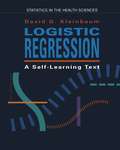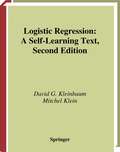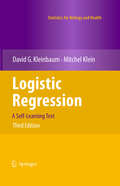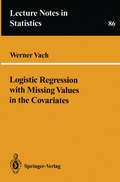- Table View
- List View
The Logic of Biochemical Sequencing
by D. BlackmanThe Logic of Biochemical Sequencing examines how to determine the primary structures of proteins and DNA and use them to stimulate the process of logical problem-solving. It concentrates on sequencing work and stresses the thought processes needed to make sense of what might otherwise be indecipherable data. The book also introduces "biocryptography," which serves as a basis for four short stories that use the results of sequence determinations to provide clues to higher order problems. Problems in the book range from elementary to difficult, and solutions to all problems are provided, many of them completely worked out. The book is an excellent supplementary text for students in a full-year biochemistry course, as well as for biochemists and molecular biologists.
The Logic of Care: Health and the Problem of Patient Choice
by Annemarie Mol**Shortlisted for the BSA Sociology of Health and Illness Book Prize 2010**What is good care? In this innovative and compelling book, Annemarie Mol argues that good care has little to do with 'patient choice' and, therefore, creating more opportunities for patient choice will not improve health care. Although it is possible to treat people who seek professional help as customers or citizens, Mol argues that this undermines ways of thinking and acting crucial to health care. Illustrating the discussion with examples from diabetes clinics and diabetes self care, the book presents the 'logic of care' in a step by step contrast with the 'logic of choice'. She concludes that good care is not a matter of making well argued individual choices but is something that grows out of collaborative and continuing attempts to attune knowledge and technologies to diseased bodies and complex lives. Mol does not criticise the practices she encountered in her field work as messy or ad hoc, but makes explicit what it is that motivates them: an intriguing combination of adaptability and perseverance. The Logic of Care: Health and the problem of patient choice is crucial reading for all those interested in the theory and practice of care, including sociologists, anthropologists and health care professionals. It will also speak to policymakers and become a valuable source of inspiration for patient activists.
The Logic of Care: Health and the Problem of Patient Choice
by Annemarie Mol**Shortlisted for the BSA Sociology of Health and Illness Book Prize 2010**What is good care? In this innovative and compelling book, Annemarie Mol argues that good care has little to do with 'patient choice' and, therefore, creating more opportunities for patient choice will not improve health care. Although it is possible to treat people who seek professional help as customers or citizens, Mol argues that this undermines ways of thinking and acting crucial to health care. Illustrating the discussion with examples from diabetes clinics and diabetes self care, the book presents the 'logic of care' in a step by step contrast with the 'logic of choice'. She concludes that good care is not a matter of making well argued individual choices but is something that grows out of collaborative and continuing attempts to attune knowledge and technologies to diseased bodies and complex lives. Mol does not criticise the practices she encountered in her field work as messy or ad hoc, but makes explicit what it is that motivates them: an intriguing combination of adaptability and perseverance. The Logic of Care: Health and the problem of patient choice is crucial reading for all those interested in the theory and practice of care, including sociologists, anthropologists and health care professionals. It will also speak to policymakers and become a valuable source of inspiration for patient activists.
The Logic of Language Development in Early Childhood (Springer Series in Language and Communication #3)
by M. MillerThe Logics of Healthcare: The Professional’s Guide to Health Systems Science
by Paul LillrankMost of the current literature on healthcare operations management is focused on importing principles and methods from manufacturing. The evidence of success is scattered and nowhere near what has been achieved in other industries. This book develops the idea that the logic of production, and production systems in healthcare is significantly different. A line of thing that acknowledges the ingenious characteristics of health service production is developed. This book builds on a managerial segmentation of healthcare based on fundamental demand-supply constellations. Demand can be classified with the variables urgency, severity, and randomness. Supply is constrained by medical technology (accuracy of diagnostics, efficacy of therapies), patient health behavior (co-creation of health), and resource availability. Out of this emerge seven demand-supply-based operational types (DSO): prevention, emergencies, one-visit, electives, cure, care, and projects. Each of these have distinct managerial characteristics, such as time-perspective, level of co-creation, value proposition, revenue structure, productivity and other key performance indicators (KPI). The DSOs can be envisioned as platforms upon which clinical modules are attached. For example, any Emergency Department (ED) must be managed to deal with prioritization, time-windows, agitated patients, the necessity to save and stabilize, and variability in demand. Specific clinical assets and skill-sets are required for, say, massive trauma, strokes, cardiac events, or poisoning. While representing different specialties of clinical medicine they, when applied in the emergency – context, must conform to the demand-supply-based operating logic. A basic assumption in this book is that the perceived complexity of healthcare arises from the conflicting demands of the DSO and the clinical realms. The seven DSOs can neatly be juxtaposed on the much-used Business Model Canvas (BMC), which postulates the business model elements as value proposition; customer segments, channels and relations; key activities, resources and partners; the cost structure; and the revenue model.
The Logics of Healthcare: The Professional’s Guide to Health Systems Science
by Paul LillrankMost of the current literature on healthcare operations management is focused on importing principles and methods from manufacturing. The evidence of success is scattered and nowhere near what has been achieved in other industries. This book develops the idea that the logic of production, and production systems in healthcare is significantly different. A line of thing that acknowledges the ingenious characteristics of health service production is developed. This book builds on a managerial segmentation of healthcare based on fundamental demand-supply constellations. Demand can be classified with the variables urgency, severity, and randomness. Supply is constrained by medical technology (accuracy of diagnostics, efficacy of therapies), patient health behavior (co-creation of health), and resource availability. Out of this emerge seven demand-supply-based operational types (DSO): prevention, emergencies, one-visit, electives, cure, care, and projects. Each of these have distinct managerial characteristics, such as time-perspective, level of co-creation, value proposition, revenue structure, productivity and other key performance indicators (KPI). The DSOs can be envisioned as platforms upon which clinical modules are attached. For example, any Emergency Department (ED) must be managed to deal with prioritization, time-windows, agitated patients, the necessity to save and stabilize, and variability in demand. Specific clinical assets and skill-sets are required for, say, massive trauma, strokes, cardiac events, or poisoning. While representing different specialties of clinical medicine they, when applied in the emergency – context, must conform to the demand-supply-based operating logic. A basic assumption in this book is that the perceived complexity of healthcare arises from the conflicting demands of the DSO and the clinical realms. The seven DSOs can neatly be juxtaposed on the much-used Business Model Canvas (BMC), which postulates the business model elements as value proposition; customer segments, channels and relations; key activities, resources and partners; the cost structure; and the revenue model.
Logistic Regression: A Self-Learning Text (Statistics for Biology and Health)
by David G. KleinbaumThis text on logistic regression methods contains the following eight chapters: 1 Introduction to Logistic Regression 2 Important Special Cases of the Logistic Model 3 Computing the Odds Ratio in Logistic Regression 4 Maximum Likelihood Techniques: An Overview 5 Statistical Inferences Using Maximum Likelihood Techniques 6 Modeling Strategy Guidelines 7 Modeling Strategy for Assessing Interaction and Confounding 8 Analysis of Matched Data Using Logistic Regression Each chapter contains a presentation of its topic in "lecture-book" format together with objectives, an outline, key formulae, practice exercises, and a test. The "lecture-book" has a sequence of illustrations and formulae in the left column of each page and a script in the right column. This format allows you to read the script in conjunction with the illustrations and formulae that high light the main points, formulae, or examples being presented. The reader mayaiso purchase directly from the author audio-cassette tapes of each chapter. If you purchase the tapes, you may use the tape with the illustrations and formulae, ignoring the script. The use of the audiotape with the illustrations and formulae is intended to be similar to a lecture. An audio cassette player is the only equipment required. Tapes may be obtained by writing or calling the author at the following address: Depart ment of Epidemiology, School of Public Health, Emory University, 1599 Clifton Rd. N. E. , Atlanta, GA 30333, phone (404) 727-9667. This text is intended for self-study.
Logistic Regression: A Self-Learning Text (Statistics for Biology and Health)
by David G. Kleinbaum Mitchel KleinThis is the second edition of this text on logistic regression methods, ori- nally published in 1994. As in the first edition, each chapter contains a presentation of its topic in “lecture-book” format together with objectives, an outline, key formulae, practice exercises, and a test. The “lecture-book” has a sequence of illust- tions and formulae in the left column of each page and a script (i.e., text) in the right column. This format allows you to read the script in conjunction with the illustrations and formulae that highlight the main points, formulae, or examples being presented. This second edition has expanded the first edition by adding five new ch- ters and a new appendix. The five new chapters are Chapter 9. Polytomous Logistic Regression Chapter 10. Ordinal Logistic Regression Chapter 11. Logistic Regression for Correlated Data: GEE Chapter 12. GEE Examples Chapter 13. Other Approaches for Analysis of Correlated Data Chapters 9 and 10 extend logistic regression to response variables that have more than two categories. Chapters 11–13 extend logistic regression to gen- alized estimating equations (GEE) and other methods for analyzing cor- lated response data. The appendix is titled “Computer Programs for Logistic Regression” and p- vides descriptions and examples of computer programs for carrying out the variety of logistic regression procedures described in the main text. The so- ware packages considered are SAS Version 8.0, SPSS Version 10.0, and STATA Version 7.0.
Logistic Regression: A Self-Learning Text (Statistics for Biology and Health)
by David G. Kleinbaum Mitchel KleinThis is the third edition of this text on logistic regression methods, originally published in 1994, with its second e- tion published in 2002. As in the first two editions, each chapter contains a pres- tation of its topic in “lecture?book” format together with objectives, an outline, key formulae, practice exercises, and a test. The “lecture book” has a sequence of illust- tions, formulae, or summary statements in the left column of each page and a script (i. e. , text) in the right column. This format allows you to read the script in conjunction with the illustrations and formulae that highlight the main points, formulae, or examples being presented. This third edition has expanded the second edition by adding three new chapters and a modified computer appendix. We have also expanded our overview of mod- ing strategy guidelines in Chap. 6 to consider causal d- grams. The three new chapters are as follows: Chapter 8: Additional Modeling Strategy Issues Chapter 9: Assessing Goodness of Fit for Logistic Regression Chapter 10: Assessing Discriminatory Performance of a Binary Logistic Model: ROC Curves In adding these three chapters, we have moved Chaps. 8 through 13 from the second edition to follow the new chapters, so that these previous chapters have been ren- bered as Chaps. 11–16 in this third edition.
Logistic Regression with Missing Values in the Covariates (Lecture Notes in Statistics #86)
by Werner VachIn many areas of science a basic task is to assess the influence of several factors on a quantity of interest. If this quantity is binary logistic, regression models provide a powerful tool for this purpose. This monograph presents an account of the use of logistic regression in the case where missing values in the variables prevent the use of standard techniques. Such situations occur frequently across a wide range of statistical applications. The emphasis of this book is on methods related to the classical maximum likelihood principle. The author reviews the essentials of logistic regression and discusses the variety of mechanisms which might cause missing values while the rest of the book covers the methods which may be used to deal with missing values and their effectiveness. Researchers across a range of disciplines and graduate students in statistics and biostatistics will find this a readable account of this.
Logistik und Qualitätsmanagement im Gesundheitsbetrieb: Betriebswirtschaft für das Gesundheitswesen
by Andreas FrodlDas vorliegende Buch befasst sich daher mit den logistischen Grundlagen des Gesundheitsbetriebs, der Gestaltung, Planung, Normierung und Standardisierung von Behandlungs- und Pflegeleistungen, weist auf die Bedeutung des Einsatzes und der Bewirtschaftung von medizinischem Verbrauchsmaterial hin und zeigt die Einsatzbedingungen medizintechnischer Betriebsmittel im Gesundheitsbetrieb auf
Logopädie bei kindlichen Hörstörungen: Ein mehrdimensionales Konzept für Therapie und Beratung (Rehabilitation und Prävention #55)
by Monika ThielDer Praxisleitfaden vermittelt Logopäden, Sprachtherapeuten und Sprachheilpädagogen einen neuartigen Ansatz für die Therapie und Elternarbeit bei hörgeschädigten Kindern mit Hörgeräten oder Cochlear-Implant.Das moderne mehrdimensionale und interdisziplinäre Konzept beinhaltet die Einbindung geeigneter Wahrnehmungsbereiche und Bewegungselemente in die Therapie. Dadurch wird beim Kind die Eigenmotivation zum Spracherwerb und die Verarbeitung von Hör- und Spracheindrücken unterstützt.Das Buch behandelt alle Praxisfragen und umfasst den gesamten Prüfungsstoff für das Fach Hörstörungen an Logopädieschulen:- pädaudiologische Untersuchungen, Anpassung von Hörgeräten und Sprachprozessoren- logopädische Anamnese, Diagnostik und Therapie- Elternberatung zu allen wichtigen Fragen und ProblemenDie Inhalte sind klar strukturiert durch Übersichten und Checklisten. Mit kopierfähigen Arbeitsvorlagen sowie konkreten Fallbeispielen, Tipps und Anregungen ist der Leitfaden als modernes Lehrbuch UND als Praxismanual gleichermaßen unentbehrlich.
Lokalanästhesie (Klinische Anästhesiologie und Intensivtherapie #18)
by F. W. Ahnefeld E. Rügheimer H. Bergmann C. Burri W. Dick M. Halmagyi G. HossliLokale anesthesie in de tandheelkunde
by J.A. Baart and H.S. BrandLokale anesthesie in de tandheelkunde is een leesbaar praktijkboek met kwalitatief hoogwaardige anatomische tekeningen en foto's in kleur. Het is een onmisbaar naslagwerk voor tandartsen, mondzorgkundigen en degenen die hiervoor studeren. Het boek geeft veel praktische informatie over de wijze waarop anesthesie kan worden toegediend en over de intraorale gebieden die bij toepassing van de verschillende methoden zijn verdoofd. De betekenis van deze handeling kan nauwelijks worden onderschat. Enerzijds zorgt lokale anesthesie ervoor dat de patiënt comfortabel en pijnvrij een tandheelkundige behandeling kan ondergaan, anderzijds stelt het de tandarts in staat deze behandeling rustig en geconcentreerd uit te voeren. Grondige kennis van de anatomie, de farmacologie en de wijze waarop de verdoving moet worden toegediend bij volwassenen en kinderen, is daarvoor onmisbaar. Ook dient men te beschikken over kennis van de lokale en systemische complicaties en het gebruik van lokale verdoving bij medisch gecompromitteerde patiënten. Aan deze tweede, geheel herziene, druk is een nieuw hoofdstuk over computergestuurde anesthesie toegevoegd. Daarnaast is op verschillende plaatsen nadrukkelijk aandacht besteed aan aspecten van veiligheid, milieu en steriliteit en komen ook nieuwe anesthesietechnieken aan de orde.Aan deze tweede, geheel herziene, druk is een nieuw hoofdstuk over computergestuurde anesthesie toegevoegd. Daarnaast is op verschillende plaatsen nadrukkelijk aandacht besteed aan aspecten van veiligheid, milieu en steriliteit en komen ook nieuwe anesthesietechnieken aan de orde.
Lokale IgG-Produktion im Liquor bei multipler Sklerose (Schriftenreihe Neurologie Neurology Series #30)
by Hayo I. SchipperLokale Therapie des Rektumkarzinoms: Verfahren in kurativer Intention
by Paul Hermanek Gian P. MarzoliLokaltherapeutische Standards für chronische Hautwunden: Ulcus cruris - Dekubitus - Kompressionstherapie - Weichlagerung
by Gerhard KammerlanderIm Mittelpunkt des Praxis-Handbuchs stehen die lokaltherapeutischen Standards und die Prophylaxe-Maßnahmen für chronische Hautwunden, insbesondere bei Ulcus cruris und Dekubitus.Es vermittelt neueste Erkenntnisse kompakt, verständlich und ganzheitlich orientiert:o Praxisorientierte Darstellung der Lokaltherapien nach Wundstadieno Zahlreiche anschauliche Farbabbildungeno Therapieauswahl nach Aufwand-Kosten-Nutzen-Faktoro Wundskala für die Zuteilung von Lokaltherapeutikao Hilfsskala zur Auswahl der WeichlagerungDamit bietet das Buch sowohl Basiswissen für die Fort- und Weiterbildung als auch spezielle Problemlösungen zum schnellen Nachschlagen im Praxis-Alltag.
Lokaltherapeutische Standards für chronische Hautwunden: Ulcus cruris - Dekubitus - Kompressionstherapie - Weichlagerung
by Gerhard KammerlanderDas praxisorientierte Handbuch behandelt die lokaltherapeutischen Standards für chronische Hautwunden nach den neuesten Erkenntnissen der Wundheilungsdynamik und der Physiologie der Wundproliferation. Die Behandlungsformen chronischer Wunden haben sich von der ausschließlich trockenen zur feuchten Wundbehandlung verschoben. Aufgrund der Verschiedenheit chronischer Wunden ist die Abklärung von metabolischen, vaskulären und malignen Ursachen jeweils vor der Anwendung lokaltherapeutischer Maßnahmen erforderlich. Durch die klare und komprimierte Zusammenfassung der neuesten Erkenntnisse aus Pathophysiologie, Forschung und Therapie werden komplexe Fachinformationen zum Thema chronische Hautwunden verständlich vermittelt. Das reich bebilderte Buch präsentiert anschaulich therapeutische Konzepte für die Behandlung. Das Handbuch ist sowohl für die Aus- und Weiterbildung als auch als Nachschlagewerk für die Lösung spezieller Probleme geeignet. Das Ergänzungsheft informiert über neue Produkte und neue Namen von bewährten Produkten, die seit dem Erscheinen der Vorauflage auf den Markt gekommen sind.
Lokaltherapeutische Standards für chronische Hautwunden: Ulcus cruris - Dekubitus - Kompressionstherapie - Weichlagerung
by Gerhard KammerlanderThe Lomidine Files: The Untold Story of a Medical Disaster in Colonial Africa
by Guillaume LachenalAfter the Second World War, French colonial health services, armed with a newly discovered drug, made the eradication of sleeping sickness their top priority. A single injection of Lomidine (known as Pentamidine in the United States) promised to protect against infection for six months or longer. Mass campaigns of "preventive lomidinization" were launched with immense enthusiasm across Africa. But the drug proved to be both inefficient and dangerous. Contaminated injections caused bacterial infections that progressed to gangrene, killing dozens of people. Shockingly, the French physicians who administered the shots seemed to know the drug;€™s risk: while they obtained signed consent before giving Lomidine to French citizens, they administered it to Africans without their consent;¢;‚¬;€?sometimes by force.In The Lomidine Files, Guillaume Lachenal traces the medicine;€™s trajectory from experimental trials during the Second World War, when it was introduced as a miracle cure for sleeping sickness, to its abandonment in the late 1950s, when a series of deadly incidents brought lomidinization campaigns to a grinding halt. He explores colonial doctors;€™ dangerously hubristic obsession with an Africa freed from disease and describes the terrible reactions caused by the drug, the resulting panic of colonial authorities, and the decades-long cover-up that followed.A fascinating material history that touches on the drug;€™s manufacture and distribution, as well as the tragedies that followed in its path, The Lomidine Files resurrects a nearly forgotten scandal. Ultimately, it illuminates public health not only as a showcase of colonial humanism and a tool of control but also as an arena of mediocrity, powerlessness, and stupidity.
The Lomidine Files: The Untold Story of a Medical Disaster in Colonial Africa
by Guillaume LachenalAfter the Second World War, French colonial health services, armed with a newly discovered drug, made the eradication of sleeping sickness their top priority. A single injection of Lomidine (known as Pentamidine in the United States) promised to protect against infection for six months or longer. Mass campaigns of "preventive lomidinization" were launched with immense enthusiasm across Africa. But the drug proved to be both inefficient and dangerous. Contaminated injections caused bacterial infections that progressed to gangrene, killing dozens of people. Shockingly, the French physicians who administered the shots seemed to know the drug;€™s risk: while they obtained signed consent before giving Lomidine to French citizens, they administered it to Africans without their consent;¢;‚¬;€?sometimes by force.In The Lomidine Files, Guillaume Lachenal traces the medicine;€™s trajectory from experimental trials during the Second World War, when it was introduced as a miracle cure for sleeping sickness, to its abandonment in the late 1950s, when a series of deadly incidents brought lomidinization campaigns to a grinding halt. He explores colonial doctors;€™ dangerously hubristic obsession with an Africa freed from disease and describes the terrible reactions caused by the drug, the resulting panic of colonial authorities, and the decades-long cover-up that followed.A fascinating material history that touches on the drug;€™s manufacture and distribution, as well as the tragedies that followed in its path, The Lomidine Files resurrects a nearly forgotten scandal. Ultimately, it illuminates public health not only as a showcase of colonial humanism and a tool of control but also as an arena of mediocrity, powerlessness, and stupidity.
London and its Asylums, 1888-1914: Politics and Madness (Mental Health in Historical Perspective)
by Robert EllisThis book explores the impact that politics had on the management of mental health care at the turn of the nineteenth and twentieth centuries. 1888 and the introduction of the Local Government Act marked a turning point in which democratically elected bodies became responsible for the management of madness for the first time. With its focus on London in the period leading up to the First World War, it offers a new way to look at institutions and to consider their connections to wider issues that were facing the capital and the nation. The chapters that follow place London at the heart of international networks and debates relating to finance, welfare, architecture, scientific and medical initiatives, and the developing responses to immigrant populations. Overall, it shines a light on the relationships between mental health policies and other ideological priorities.
London Belles
by Annie GrovesLondon Belles is a tale of four very different young women thrown together by war. Finding freedom and independence – as well as love, passion and heartbreak – for the very first time, a unique bond is formed as the hostilities take their toll on Britain.
The London Lupus Centre, Book of Lupus: A Patients' Guide
by Graham HughesLupus is an extremely common, potentially treatable, disease of the immune system. It affects approximately 1 in 1000 women and is more common than diseases such as multiple sclerosis and leukaemia. Despite this, there is little information concerning the disease in contrast to other illnesses of similar prevalence. Many people are unaware of the symptoms, treatment, and prevention of lupus. It is important that these topics are highlighted for many reasons. For example, a greater understanding of the symptoms of lupus will enable patients to recognise the symptoms earlier, and get treatment faster; before any serious damage is done. Similarly, awareness of preventative measures may reduce the number of cases of lupus that occur. From a different perspective, it would be of great use to have an easily accessible source of information available to lupus patients that would highlight issues such as treatment options and sources of support. In summary, although knowledge of lupus is growing, greater awareness of the disease amongst both patients and the general public is an issue that needs to be addressed.





















